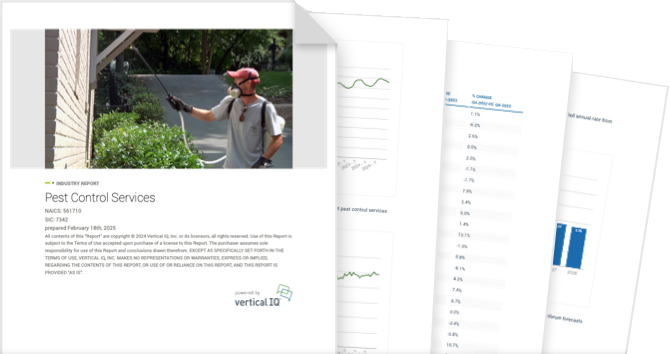US Product Rental and Leasing Sector NAICS 532

Unlock access to the full platform with more than 900 industry reports and local economic insights.
Get access to this Industry Profile including 18+ chapters and more than 50 pages of industry research.
Industry Summary
The 51,000 product rental and leasing establishments in the US provide the use of commercial and consumer goods in return for lease or rental payments. Establishments may rent or lease nonfinancial intangible assets, including patents and trademarks (but excluding copyrighted works).
Seasonal, Uneven Demand and Cash Flow
Cash flow in the equipment rental/leasing sector is seasonal and driven by the dynamics of downstream industries.
Variability in Residual Value
Firms are exposed to financial risk when the market value of a vehicle or rental good is less than its depreciated value (residual value) when it is sold.
Recent Developments
Dec 4, 2025 - Apparel Rental Gains in Popularity
- Amid rising apparel costs and shifting consumer habits, clothing rental platforms are gaining traction as budget-friendly alternatives, according to NPR. More than half a million women rent clothes, finding it cheaper and more flexible than buying. The apparel rental industry is valued at $2.6 billion and is projected to more than double by 2035, according to Future Market Insights. The industry has benefited from inflation and tariffs, which have driven up clothing prices. Companies like Nuuly and Rent the Runway are expanding inventory to meet holiday demand, though tariffs and supply chain delays pose challenges. Rental services appeal to consumers seeking fresh wardrobes without long-term commitments, offering convenience and cost savings while reshaping how fashion is consumed.
- Megaprojects drove substantial gains for the total value of construction starts in October compared to September, according to Dodge Construction Network. Nonbuilding construction starts jumped 59.4% in October, led by a 384.5% surge in utilities and an 18.6% rise in environmental public works. Highway and bridge starts were down 23.7%. Nonresidential building construction starts increased 17.9% in October compared to the previous month, amid a 19.5% rise in commercial starts, led by data centers (+45.5%) and retail stores (+15.1%). Institutional starts grew 3.7% due to project categories other than education and healthcare, which saw starts fall 20.8% and 2.7%, respectively. Residential starts dropped 15.4% in October, with single-family starts down 2.2% and multifamily starts down 38.5%. Dodge said 10 projects valued at $1 billion or more broke ground in October, primarily in data centers, manufacturing, and liquefied natural gas (LNG) facilities.
- The average length of car rental for collision repairs decreased to 15.5 days in Q3 2025, down 0.9 days year-over-year, continuing a trend toward shorter durations as supply chains stabilize, according to Enterprise Mobility. Faster parts delivery, especially for OEM and alternative parts, helped reduce repair times, with the median delivery time dropping to 6.8 days from 9.5 days. Shops reported minimal backlogs, with 24% able to schedule repairs immediately, a nine-year high outside the pandemic. Regional differences persisted, with Alaska posting the longest rental periods and North Dakota the shortest. Colorado saw the sharpest improvement, dropping three days. Enterprise Mobility’s data suggests that the industry is nearing pre-pandemic norms, with continued efficiency gains expected to persist into 2026.
- The Equipment Leasing and Finance Association’s (ELFA) Monthly CapEx Finance Index (CFI) showed new business volume was valued at $10.5 billion in October 2025, flat from the month before. On a year-over-year basis, new business volumes increased 5.7% in October. New business volume declined 1.4% in the first 10 months of 2025 compared to the same period in 2024. ELFA CEO and President Leigh Lytle said, "Equipment demand was unfazed by the government shutdown in October. The latest data showed businesses continue to invest despite a volatile and unpredictable fall. At the current pace, 2025 will end up as the second-best year for equipment demand in the history of our CFI survey, which goes back to 2006. We’re going to see momentum really build as we put the government shutdown further in the rearview. The path for interest rates remains uncertain, but that doesn’t change the fact that our industry is financially healthy, setting us up for a strong start to 2026."
Industry Revenue
US Product Rental and Leasing Sector

Industry Structure
Industry size & Structure
The product rental and leasing services sector is comprised of 51,000 establishments that employ 577,300 workers and generate $210.6 billion in annual revenue, according to government sources.
- The product rental and leasing services sector represents 1.5% of the nation's Gross Domestic Product (GDP) and employs 0.4% of the country's workers.
- The sector is concentrated with the 20 largest firms representing 48% of revenue.
- In addition to employer establishments, the product rental and leasing services sector has 123,000 owner-operated establishments with no employees. Subsectors with the highest numbers of nonemployer establishments are commercial and industrial machinery and equipment rental and leasing (29%); automotive equipment rental and leasing (35%); and consumer goods rental (27%). The owners of nonemployer establishments typically perform the work and may outsource support functions like marketing and accounting.
- The product rental and leasing sector has shed about 4,100 establishments annually, which equals about 8.7% of existing establishments. However, the sector has added about 4,300 new establishments annually, which is equivalent to 8.4% of existing establishments. As a result, the sector has an average loss rate of 0.3%.
- The product rental and leasing sector is forecast to grow its employment base by 3.6% overall in 2024-2034, which is slightly higher than the national average of 3.1% for all jobs, according to the Bureau of Labor Statistics.
Industry Forecast
Industry Forecast
US Product Rental and Leasing Sector Industry Growth

Vertical IQ Industry Report
For anyone actively digging deeper into a specific industry.
50+ pages of timely industry insights
18+ chapters
PDF delivered to your inbox
